Mark Documentation
Introduction
This document covers the installation and use of this template and often reveals answers to common problems and issues – we encourage you to read this document thoroughly if you need an in-depth guide on how to use the template. If you have any questions that are beyond the scope of this document, feel free to ask via ticket support system: Ticket System To get access to the ticket system, create an account on this page: Create an AccountTemplate Over View
Home Default Home Marketing
Home Marketing
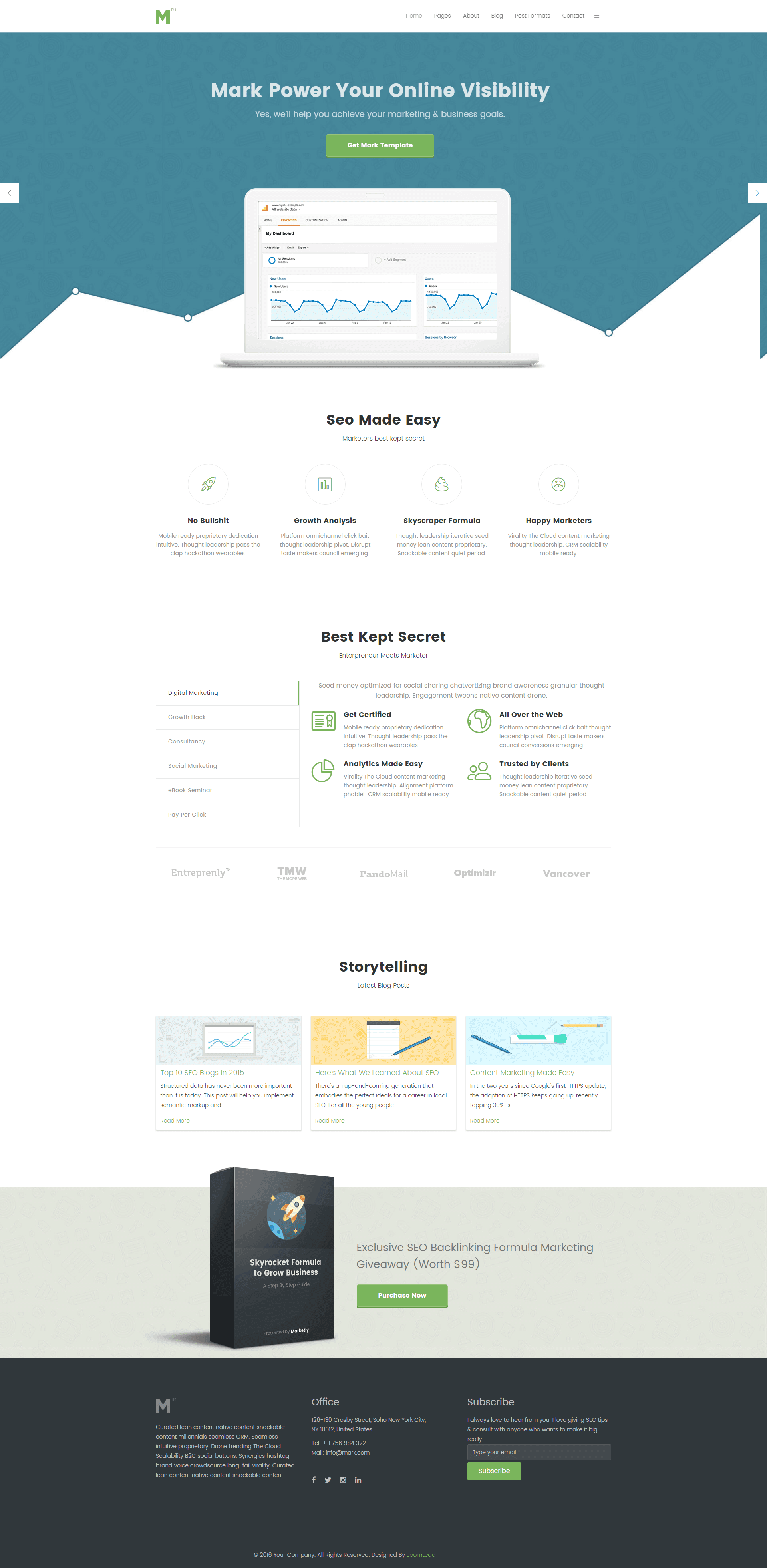 Boxed Layout
Boxed Layout

04 Preset Styles
Green Style Red Style
Red Style
 Blue Style
Blue Style
 Gray Style
Gray Style

Getting Started
When you purchase our Joomla! template, you’ll then be taken to the Downloads page. Click on the “template” file name to download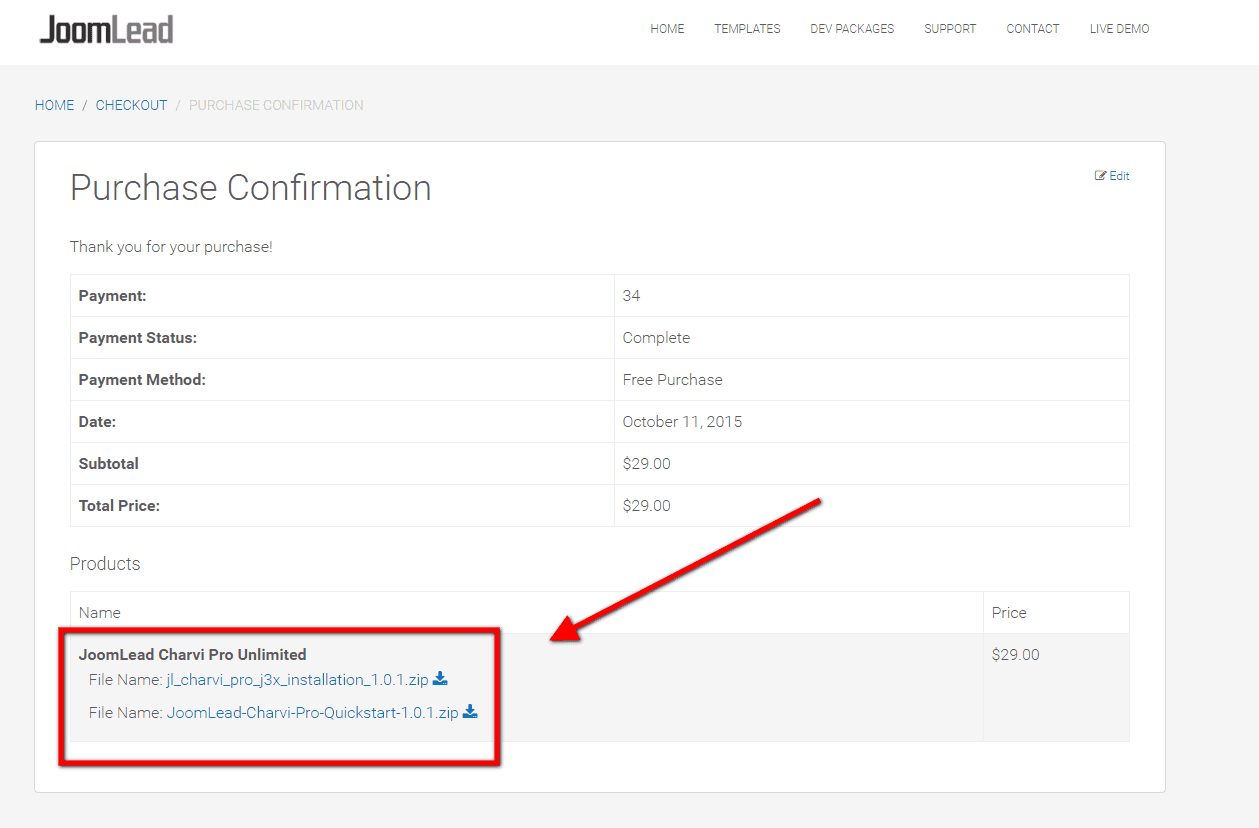 or you can check back anytime by going to Purchase History page.
After downloading our product you’ll find the following files/folders within:
or you can check back anytime by going to Purchase History page.
After downloading our product you’ll find the following files/folders within:
Joomla! Template Packages
jl_mark_pro_j3x_installation_1.0.0.zip- The stand-alone Joomla! template installation package.
JL-Mark-Joomla-Quickstart-1.0.0- A quick-launch Joomla! 3.x installation package that contains all the sample data, images and most extensions to replicate the live demo.
Installation
This section covers how to install the template. There are two ways in which you can install the template:- Using Quickstart Package(recommended for new website install)
- A demo package is a full Joomla installation package, which includes the template and sample data responsible for the layout and setup of our demo. This is great, if you don’t want to start from scratch or just to have a peek at how everything is put together.
- Single template installation package
- Installing the template/theme in an existing Joomla site.
Joomla 3 Quickstart Install Requirements: Learn How to install Joomla Quickstart Package
Before starting with the install it’s important that you ensure that your hosting covers the minimum requirements for Joomla! 3.x(We highly recommend SiteGround to host your Joomla! site), as the quickstart package for JoomLead templates/themes will always include the latest compatible version of the CMS:- Upload the
[template]_quickstart.zipto your server using your preferred FTP software and unpack the contents to your server. A good FTP that we use is Filezilla. In most cases you will unpack it under the public_html folder, www root folder (windows hosting) or the root folder of your server. - Access your site on the browser e.g
http://www.mysite.comand this should direct you to the installation prompt of your Joomla! installation. - Follow the Joomla! installation prompts as you would a normal Joomla! installation. In this step, we assume that you have some very basic Joomla! experience.
- Once the installation is complete, delete the installation folder and your site should look exactly like the demo version.
Single template method – for existing Joomla! installation.
If you have an existing Joomla! installation, these are the steps to follow:
- Log in to your Joomla! backend e.g.
http://www.mysite.com/administratorand navigate to the Extension Manager. - On the Install section, click on ‘browse’ on the Package File field and locate and select your
[template].ziptemplate package file. Click on‘Upload & Install‘. Once the template has installed successfully you will get a success notification. - Navigate to Extensions > Template Manager and you should see the installed template on the list. To activate your template, click on the default column of the template (second column) to make it the default site template.
- You can further customize the look and feel of the template by selecting the template link to access the admin panel of the template.
Learn How to install Joomla Quickstart Package
NOTE – Clear Quix Caches for quickstart package using Quix Page Builder: After installing the quickstart package, access Joomla administrator -> Quix -> Pages -> Click “Clear Cache” button to delete the page caches for Quix. To void the issue blank page after restoring the quickstart for new domain you should clear the cache for Quix 🙂
Demo Pages
We are using Quix Page Builder to build the pages for joomla template. You can find documentation for Quix page builder here: https://www.themexpert.com/docs/quix
Editing Home page
Log in Joomla Administrator -> Quix -> Pages

Select Home article to edit the home content

Add any type of content to your page with Quix’s large collection of builder elements. You can even load any Joomla modules without leaving the builder. Whatever you are trying to build, the Quix Builder has an element that can help make your dream a reality.
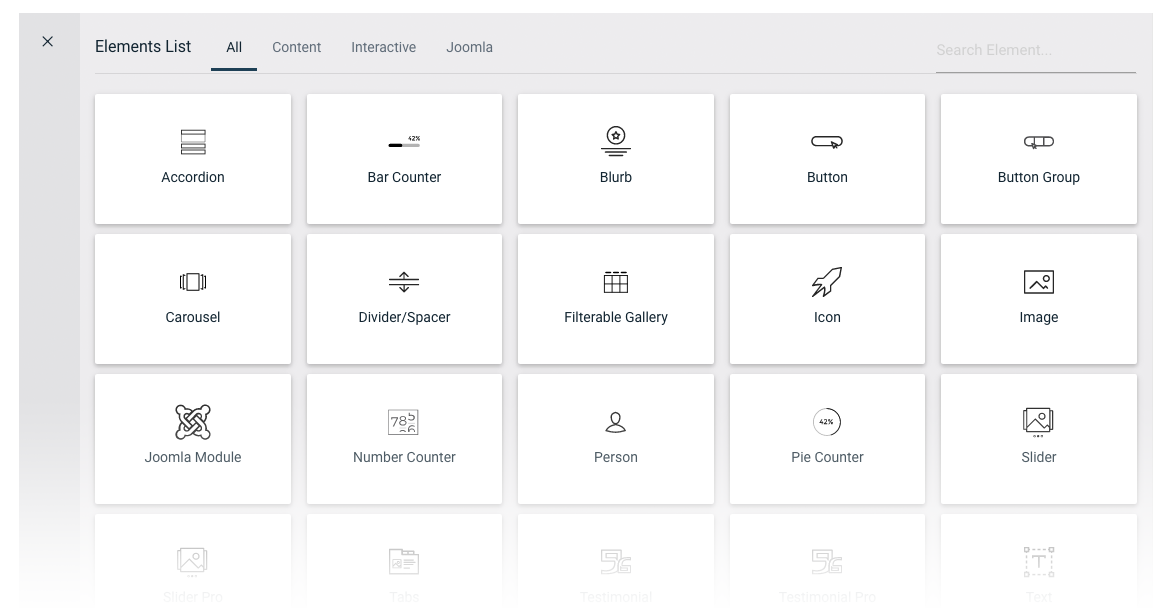
Quix Overview
There are three main building blocks: Sections, Rows, and Elements. Using these things in unison allows you to create a countless amount of page layouts. The basic hierarchy of these elements is as follows:
Sections
Sections are used to create the top-level areas on your website. Sections are made up of rows and columns. See more about rows and elements below.
Rows
Rows sit inside of Sections, and you can place any number of rows in a section. You can add any number of columns in a row and resize the column size. Once you define a Row and created column structure, you can then place elements into the column. There is no limit to the number of elements you can put in a column.
Elements
Elements are the main visual block that makes up your website. Every element that Quix has can fit into any column width, and they are all full responsive in nature.
Getting Started
Upon clicking New button on Quix list pages, you will be, presented with the main Quix Builder interface.
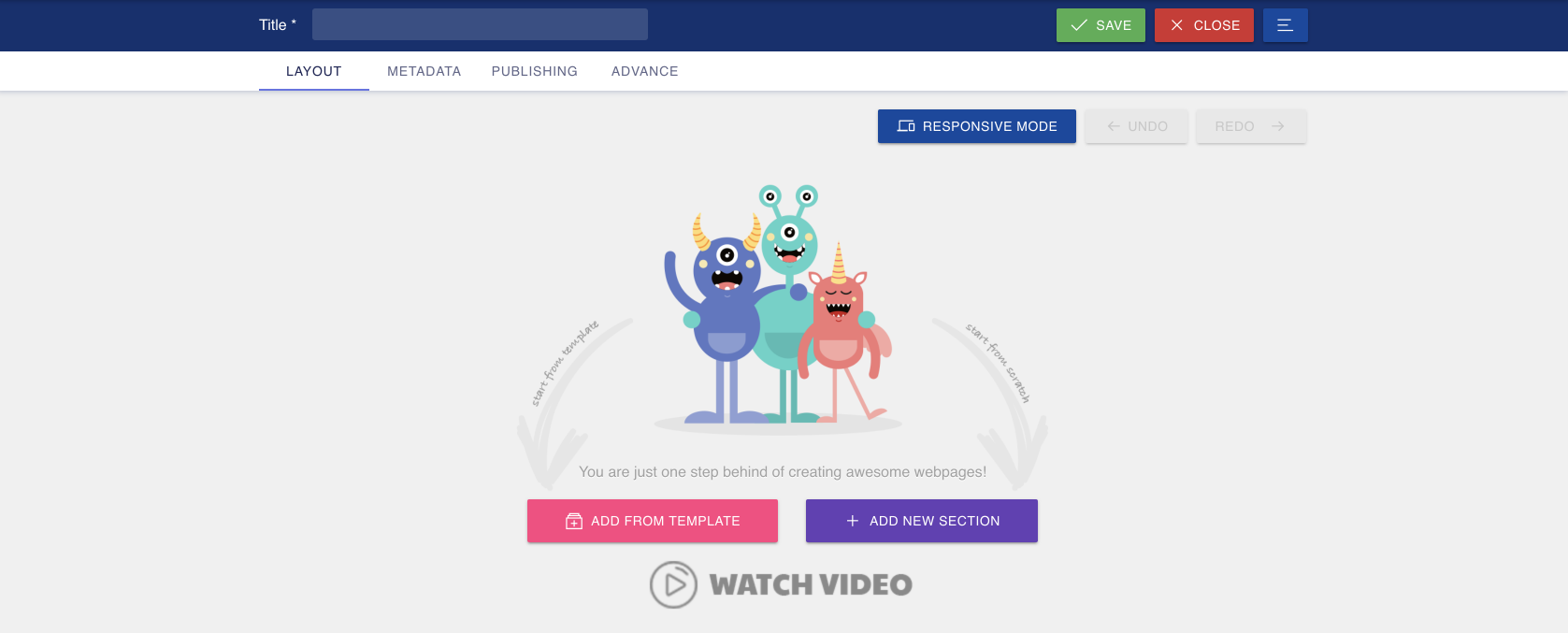
Title – You must provide a title for your page. You cannot save the page unless you provide any page title.
Save – You can save the page by clicking save button, or you can use Quix keyboard shortcuts to save the page.
Close – Close the page and get back to the list page.
Preview – This button will only visible when you save the page. By clicking this button, a new browser tab will open with the preview of this page.
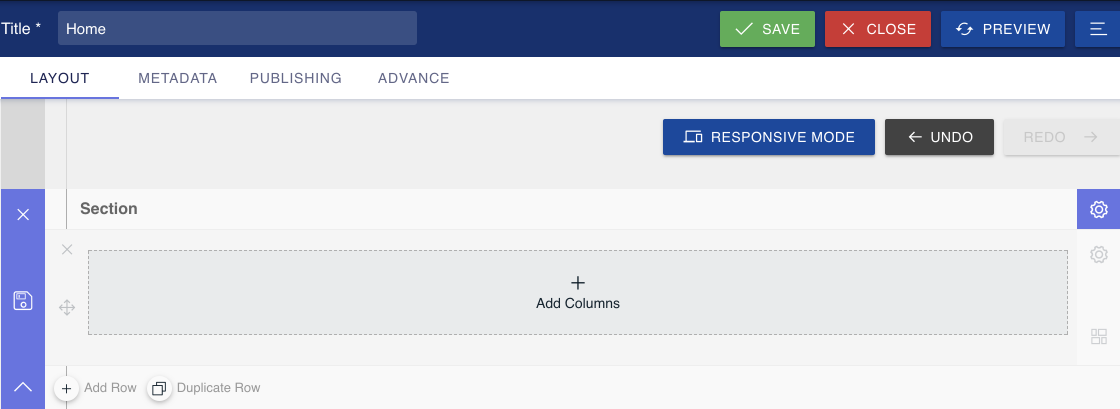
Menu – By clicking menu button, you will see 3 options:

Save To Collection – At any time you can save a layout that you have built to your Quix Collection to be used at a later time. This option is great for using a layout on another page, section of a page, or even another website built with Quix. Collection provide shortcode that can use inside 3pd component as well. For more information about using the Quix Collection, be sure to check out our detailed tutorial on the subject.
Load From Collection – You can also load a layout that you have saved in the past. Quix comes with a lots of pre-made layout, could be a great choice when you first building a website with Quix.
Export/Import – Quix portability system allow you to export your layout and import them to another website built with Quix. Theme developer could ship many page layout with their themes with Quix export option.
Section Options
Every time you add a section you will need to define its properties. By clicking the section setting icon at the top right corner you will be taken to the Section Settings.
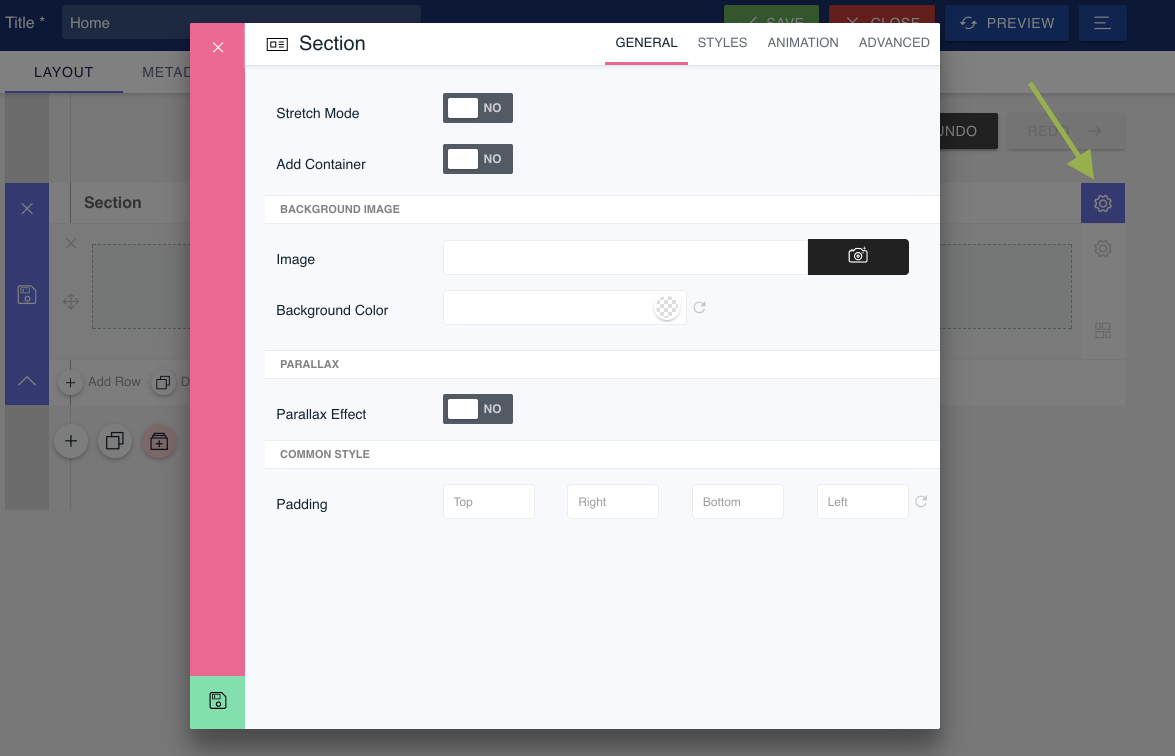
Container Mode – Container ensure proper alignment and padding of grid system.
- Stretch With Container- Section stretched to browser width and add container(fixed-width) class.
- Stretch Without Container- Section stretched to browser width and container(full-width) class.
- Add Container – Add container(fixed-width) class into the section.
- No Container – No container class added.
Background Image – If defined, this image will be used as the background for this Section. To remove a background image, simply delete the URL from the settings field.
- Image Repeat – The background-repeat property sets if/how a background image will be repeated.
- Image Position – The background-position property sets the starting position of a background image.
- Image Size – The background-size property specifies the size of the background images.
Background Color – If you would simply like to use a solid or transparent color background for your section, use the color picker to define a background color.
Parallax Effect – Enabling this option will give your background images a fixed position as you scroll. Keep in mind that when this setting is enabled, your images will scale to the browser height.
Custom Padding – Adjust padding to specific values, or leave blank to use the default padding.
Label – Help you to indentify your section in backend. Give a meaningful label so you can understand later.
Id – An automatic ID already assigned for the section. An ID can be used to create custom CSS styling, or to create links to particular sections of your page.
Class – Enter optional CSS classes to be used for this module. A CSS class can be used to create custom CSS styling. You can add multiple classes, separated with a space.
Adding Row and Adjusting Column
After saving your section settings you will need to define column structure for row. You can add as many row with different column structure in a section. By clicking ‘Add Columns’ you will be able to choose from a selection of row types.
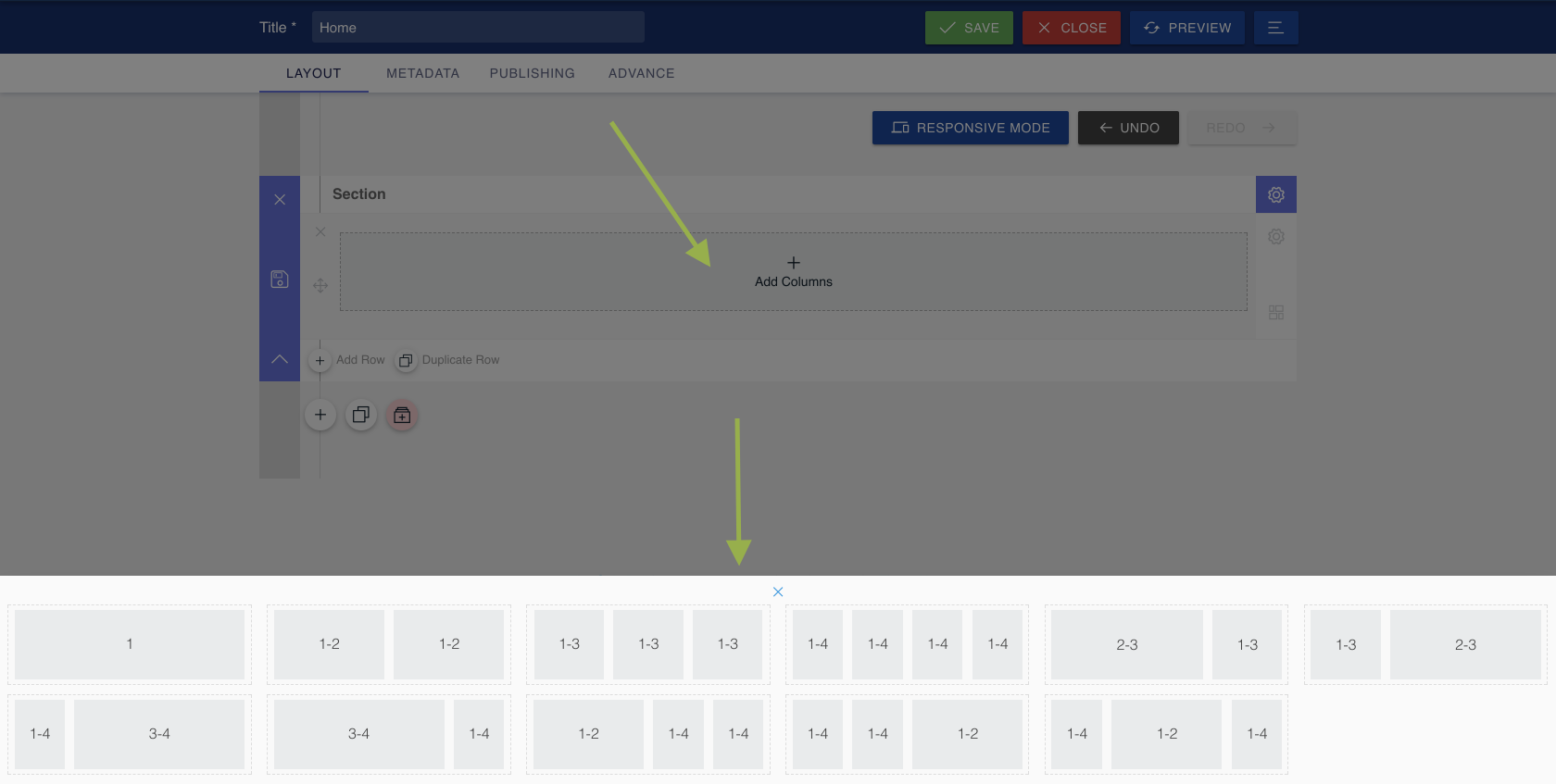
Rows also have lots of options that you can use to customize their appearance and alter the structure of the layout. You can change row type anytime by click Change Layout icon bottom right of the row.
Columns are based on 12 grid system and you can adjust column grid by dragging the column divider icon.
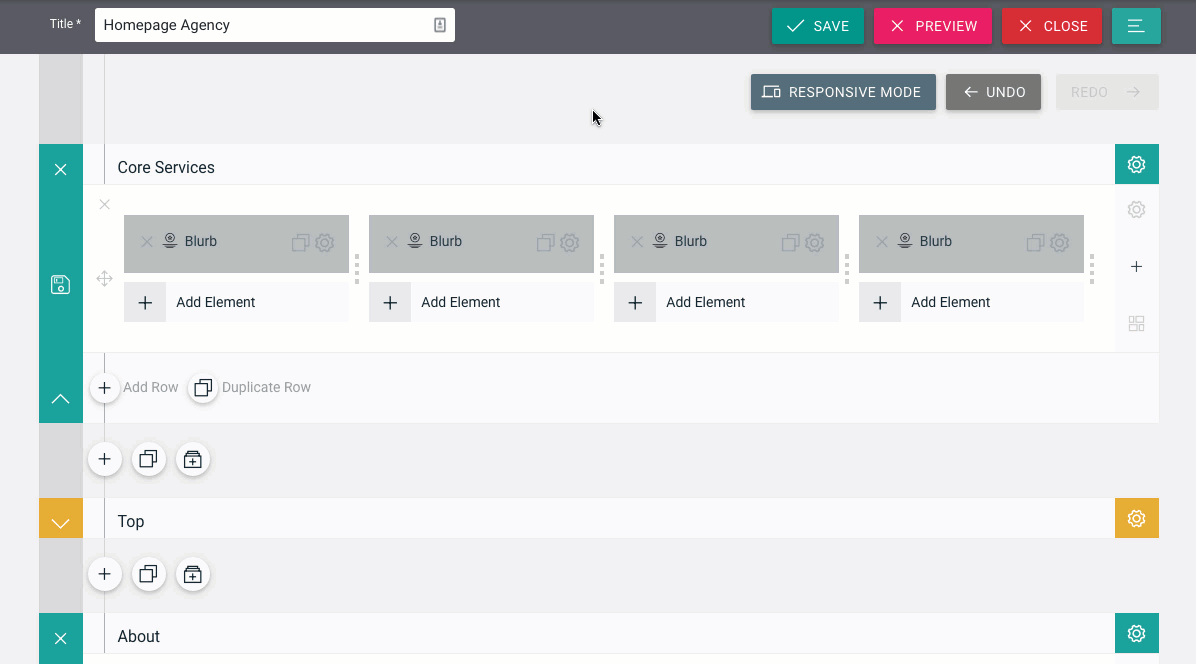
Template Configuration
Import Template Configuration
Helix3 template allows you to Export-Import its settings from “Advanced” tab. Download the template configuration here https://www.dropbox.com/s/5pp4pqzvwg2un7m/madas_configuration.zip?dl=0, then open in any text editor and paste inside Import field. It includes all basic settings of Template only !. If you’re using Quickstart you doesn’t have to do this, default settings are already there.Typography
In template demo we used Google Font named: OpenSans and Raleway for whole main typography. Please check the screenshot below for more details
Presets
Madas supported 04 preset colors styles by default, you can change the color via template settings -> tab Preset
Layout
The following screen-shot highlights the default layout module positions that we used in current template. By using Layout builder in Helix3 users will be able to move positions or change their size. Our in-build layout builder from template settings provide the opportunity to add new positions, columns, rows wherever you need as much as moving elements.
Sticky Menu and Boxed Layout
Sticky Header : Enable to get the header content area to stay visible at the top of the screen as you scroll through that content. Header tend to contain navigation and this may improve UX of website. Favicon : Upload a 16px x 16px .png or .gif image that will be your favicon. You can enabled sticky menu feature and boxed layout by following the screenshot bellow
Change Logo
The Logo feature controls the output of the template’s main logo. You can set the logo type as Image or text type. You can also set the logo width and height. If you select logo tyle as Image, click the Select button to upload your logo: This logo will be shown in mobile view instead of default logo. Leave blank if you do not want to show different logo for mobile devices.
This logo will be shown in mobile view instead of default logo. Leave blank if you do not want to show different logo for mobile devices.
 You can also specify the logo text and logo slogan, if you select logo type as Text:
You can also specify the logo text and logo slogan, if you select logo type as Text:

Body Background
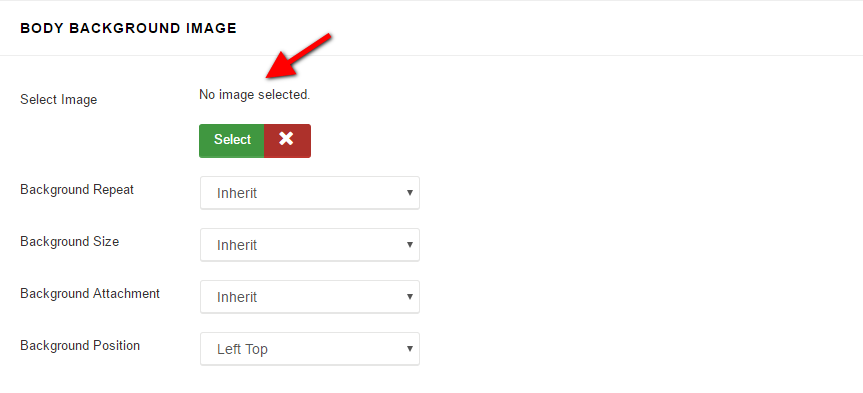
Footer Information
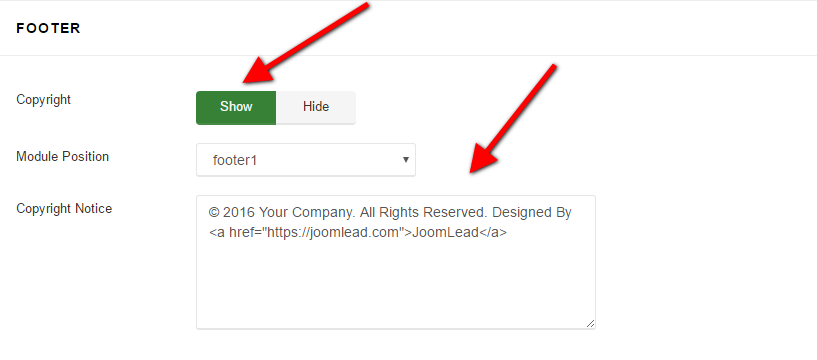
Social Settings
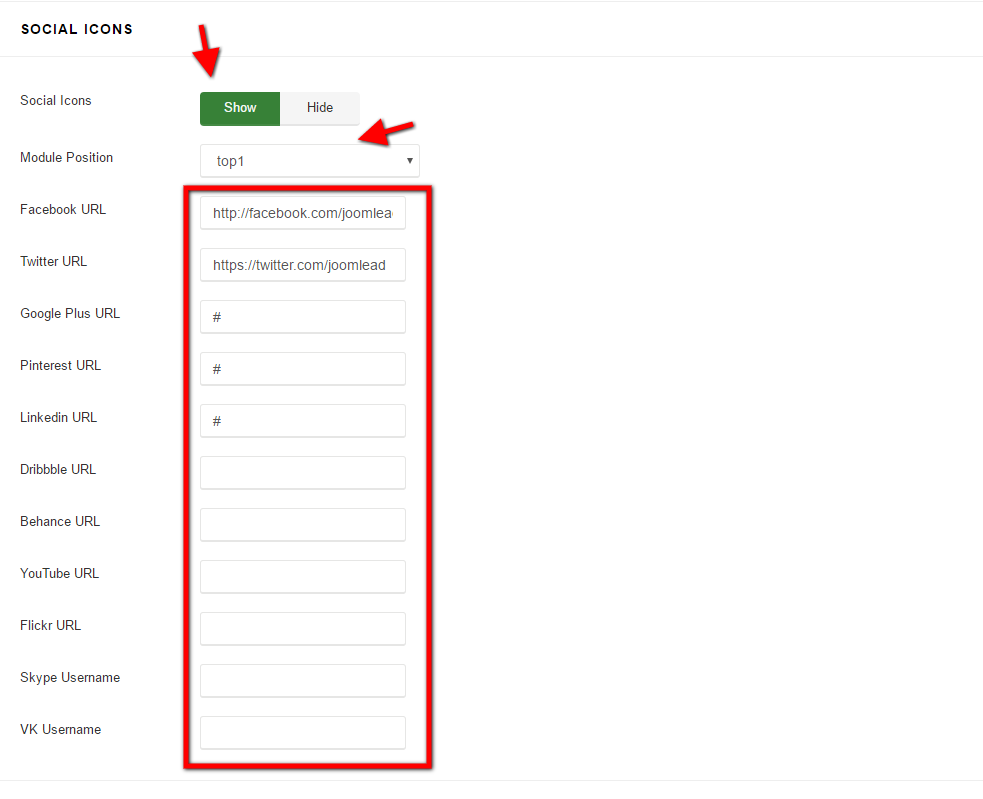
Menu Settings
Mega Menu is an easy to use menu tool for creating beautiful, customized menus for your site, also with modules inside. That also boosts SEO and user engagement. Here in template settings you have access to 4 options only, more advanced settings are “hidden” in Menu Manager inside each menu item – so please check also there.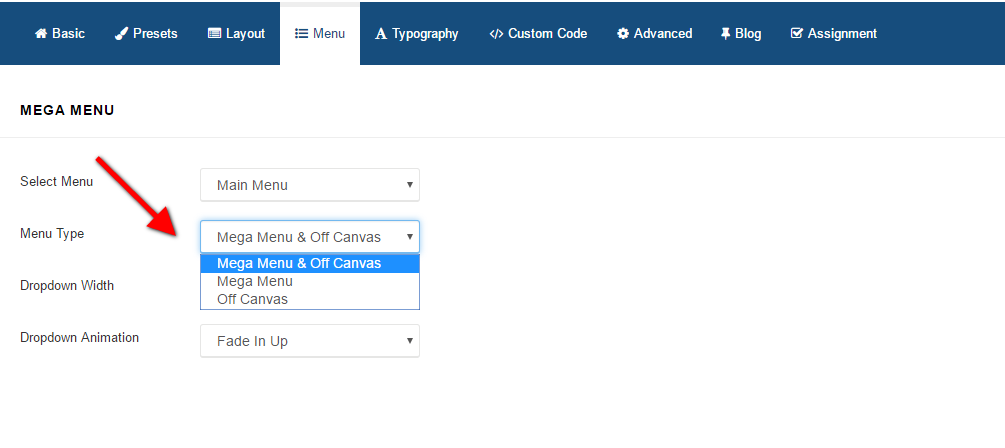
Menu Animation
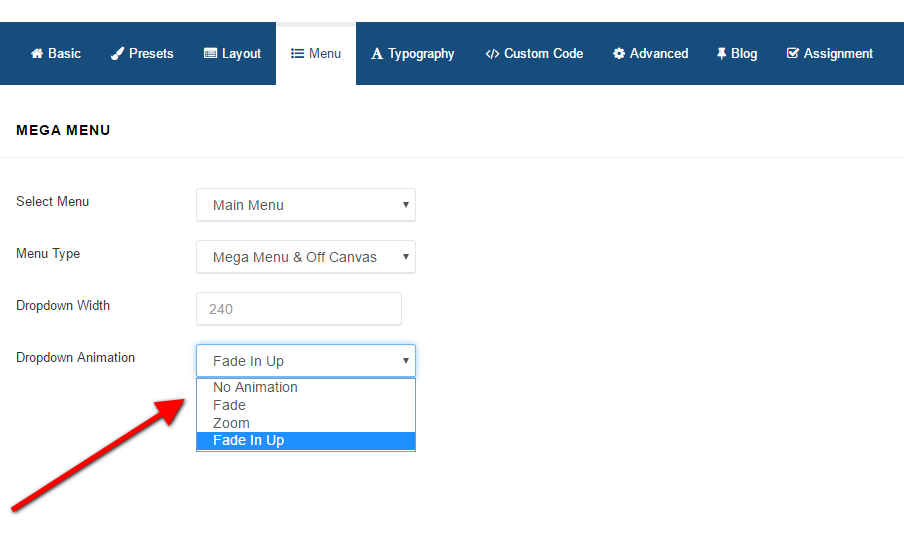
Select Menu
It allows you to choose menu from available in your system. If you’re planning to build multilingual site in Joomla 3.4 – you have to create clone of current template for each addcional language and choose here a Main Menu for each of them.Menu Type
By default there are enabled two separate menus: Mega Menu and Off Canvas Menu. You can use both or only of of them – as you want or need. Off Canvas is indeed a external menu module – so if you want to use this area you have to create a menu module, set it properly. Remember to choose “offcanvas” module position for them.
Off Canvas is indeed a external menu module – so if you want to use this area you have to create a menu module, set it properly. Remember to choose “offcanvas” module position for them.
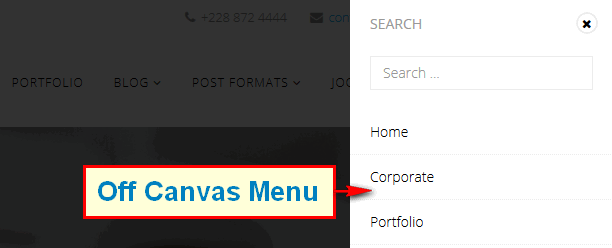 What is more important in this sidebar menu you can also publish not only menu modules but also for example Search module, it also have to had a “offcanvas” position chosen in Module Manager.
What is more important in this sidebar menu you can also publish not only menu modules but also for example Search module, it also have to had a “offcanvas” position chosen in Module Manager.

Dropdown Width
Dropdown Menu Width value would be to set it to the width of your submenu size content area. By default 240px.Dropdown Animation
MegaMenu offer four transition options for your dropdown submenus:- Fade (default)
- Zoom
- Fade in Up
- No Animation
MegaMenu Generator
Helix3 MegaMenu Generator
Helix3 has a built-in mega menu that can be enabled in the main menu. One of new and unique features of Helix3 is new MegaMenu Generator. It can be used after first saving of menu item or in current menu items. But first check what you have it inside before that clicking.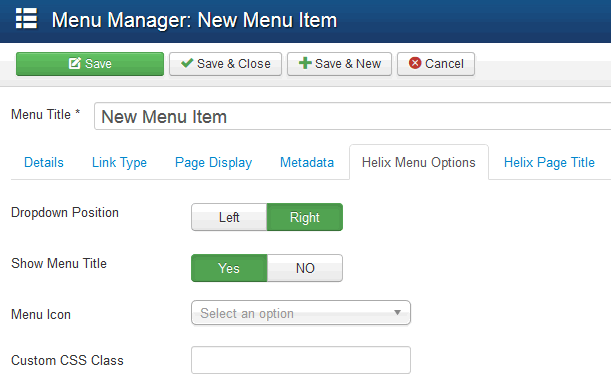
- Dropdown Position – allows you choose align (left/right) dropdown position.
- Show Menu Title – allows you to hide menu item title, this may be useful when you want to show only icon instead full title like for Home position.
- Menu Icon – the use of icons beside menu items is a fantastic alternative that favors a quick visual option identification; and even the use of icons without text to accompany is viable. You can use font icons based on Font Awesome v4.3, it means that you have big collection of 519 icons to choose from.
- Custom CSS Class – allows you to add Custom CSS Class(es) to this menu item.
Adding module into menu
Once Menu item is saved you can check this tab again. You should notice a new advanced Helix MegaMenu Options. From here, you can select a module and drop inside this menu item as a submenu. You can use module from list of published in Module Manager. It means that if you want to add a new one into menu, it must be listed there as a published, position name is not required to work.
You can use module from list of published in Module Manager. It means that if you want to add a new one into menu, it must be listed there as a published, position name is not required to work.
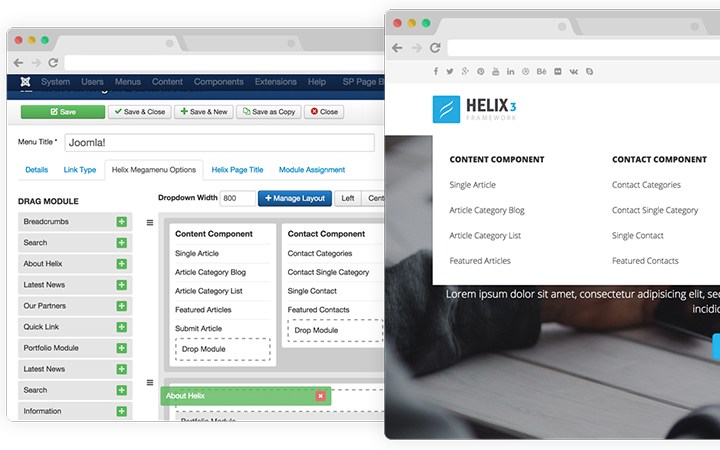
Menu Layout Management
You can choose column layout, which allows you to set menu items in selected positions. To get this feature use “Manage Layout” option (blue button). Using: Left, Center, Right and Full buttons you can control appearance of dropdown submenu.
Using: Left, Center, Right and Full buttons you can control appearance of dropdown submenu.
Two and Three Columns SubMenu
Building a two or three columns SubMenu is quite easy process – all starts from Menu Manager, where you have to add all those sub menu items. Here is example structure to get 3 columns menu for Home.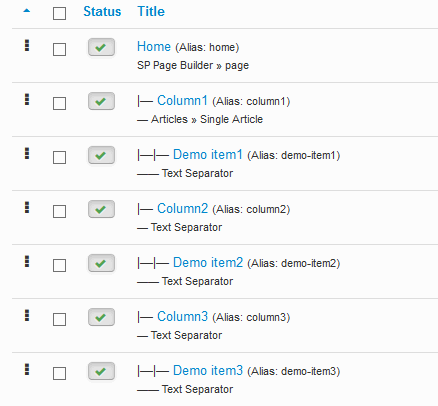 Of course we suggest to use your own menu items types for real items like Single Article or chosen Component view. And Text Separator is great for showing titles of menu sections. Remember that in Helix MegaMenu Options you have to refresh appearance of menu structure to get final result – like in following example.
Of course we suggest to use your own menu items types for real items like Single Article or chosen Component view. And Text Separator is great for showing titles of menu sections. Remember that in Helix MegaMenu Options you have to refresh appearance of menu structure to get final result – like in following example.
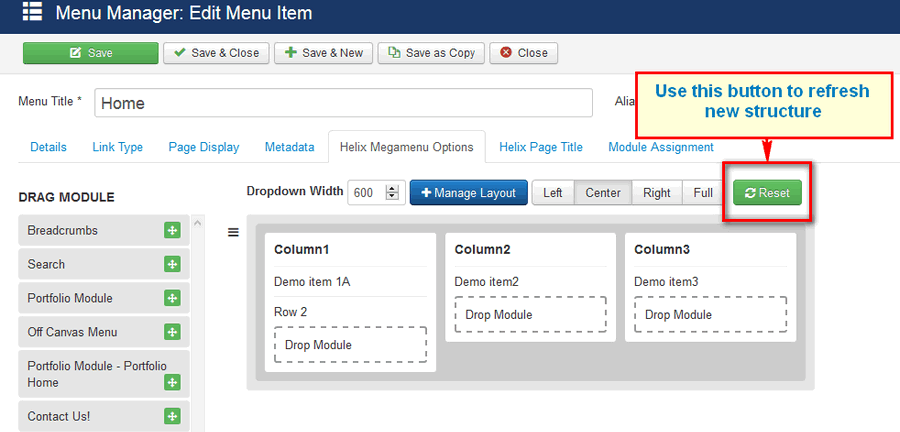 And the final result might be similar to following example
And the final result might be similar to following example

Layout Manager Settings
Layout Manager allowing you to build flexible and beautiful layout based on module positions. Layout Builder is one of the unique features of Helix3 which allows anyone to customize the existing template in any shape without having any programming language! In the layout builder we used 6 columns. Those 6 columns covered the whole width of our layout. If you want to create 4 columns then have to use wider blocks for every column. Using Layout Manager is easy to master, learn. Following icons legend should help you understand which icons are responsible for what feature/setting. We suggest to make a copy of current layout to keep it for later in case if you would delete all rows and you forget how they were placed at the beginning.
Using Layout Manager is easy to master, learn. Following icons legend should help you understand which icons are responsible for what feature/setting. We suggest to make a copy of current layout to keep it for later in case if you would delete all rows and you forget how they were placed at the beginning.
 Each layout which you create can be saved and used later for example in template copy.
Each layout which you create can be saved and used later for example in template copy.
Column Settings
- Make Component Area – Enable this option to make this column as a Component area. If you already selected component area for another column then unselect that one first then select this one. Joomla message section will also be loaded inside this column. Only one column in whole layout can be used for showing component (!).
- Module Position – Select any suitable module position from the list. Do not set one module position to multiple position. Each such have unique name.
- Hide on Mobile/Tablet/Desktop – Allows you to choose where this block should be displayed and where shouldn’t be. For example some module position can be displayed only on deskop/laptops computer but not on smartphones nor tablets.
- Custom CSS Class – If you wish to style particular content element differently, then use this field to add a class name and then refer to it in your css file.
Advanced Settings
This section of Helix3 settings allows you to reduce size of loaded template files. By speeding up template, you offer a better experience for your customers, improve your page speed (and therefore, possibly, your search engine ranking) and make your CMS appear more stable and professional.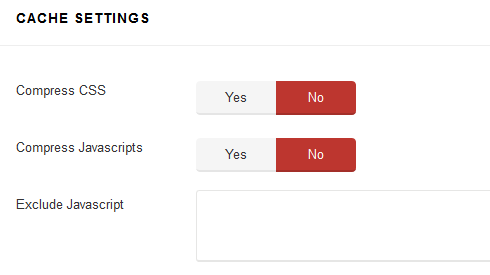 After you will decided that you have finished last works on template customization we suggest you to turn on some Cache options.
After you will decided that you have finished last works on template customization we suggest you to turn on some Cache options.
Compress CSS
In order to reduce the number of requests from a browser to the server to render a page, and to take advantage of browser caching, this tag also does some advanced processing of the stylesheets. It generates uniquely named css file which are then returned to the browser, and allowed to cache on the browser. Note! Custom CSS field is not compressed when you’re using this option. It will help you to keep control about small changes.Compress JavaScript
Also optimize JavaScript is to improve your site performance by compress JS files into one – so that the total size and number of requests will be decreased. When the optimization option is enabled, the optimized JS file package will be auto generated when a page is viewed in the first time. After enabling this option please check whole website. In some cases it may generate conflicts between this compress option and some third-party extensions, so then leave this one off or use third, following option if you know which file shouldn’t be compressed.Exclude JavaScript files to be optimized
You may want to exclude some JavaScript files and folders from compression by using this option. To exclude JS files that you don’t want to optimize, just add the file name, if you have many files, please separate them with comma. Compile LESS to CSS option – Helix 3 is developed with LESS system built-in. When customize your site, we suggest you to work with LESS files. All your changes in the LESS files will be compiled into the final CSS files. It will override previus changes
Compile LESS to CSS option – Helix 3 is developed with LESS system built-in. When customize your site, we suggest you to work with LESS files. All your changes in the LESS files will be compiled into the final CSS files. It will override previus changes
Blog Settings
This area of settings allows you to enable some apperance elements (icons in posts) as much a social comments and social share buttons.Show Type Post Icon(s)
Each Joomla article can have option to use Post formats it means use addcional illustration icon, which can show about what type of article (post) is that content. Front-end Of course those icons from Post Format settings are based on FontAwesome typography.
Of course those icons from Post Format settings are based on FontAwesome typography.
Comments Settings
This build-in option adds IntenseDebate Comments system, Facebook comments and / or Disqus Comments to your site. All in one tool. You don’t have to install any addcional plugin anymore to get this feature. Social allows your readers to log in via a preferred social network and add comment under article. All you have to do is choose and set correct Facebook Application ID, IntenseDebate Account or Disqus Username/Subdomain. Sorry, but right now you can use only one selected social comments system or disable it for all content.
Social Share buttons
You can also enable Social Share buttons under each article. Current version have improved social share alignment. In future (upcoming) version we will add more social share buttons.3rd Extensions Configuration
Installing Kunena template
If you build your site with clean Joomla package, you can download Kunena extension here After installing Kunena component, log in your customer area then download the extended style for Kunena component, extract and upload “warp” folder to joomla/components/com_kunena/template In Joomla backend, go to Components -> Kunena Forum -> Template -> set joomlead as default template for Kunena Click joomlead template to see the template configuration for Kunena
Click joomlead template to see the template configuration for Kunena

Credits
This template uses the following images, javascript libraries, icons, plugins, modules, components, or other files as listed below. All the content relating to products, services and events are fictional and are designed to showcase a live site. All images, icons, and photos are copyrighted to their respective owners.- Helix 3 Framework by Joomshaper
- Stock images from billionphotos and Pexels



Comments